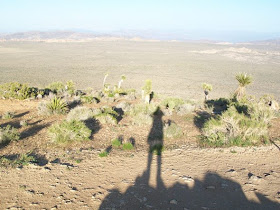 Me and my shadow, looking east, from Ryan Mountain
Me and my shadow, looking east, from Ryan MountainAfter getting back to my car in Cottonwood Springs, I drove to the visitor center, washed up, ate lunch, and rehydrated.
I had stopped at the Fresh and Easy in Indio on the way in. They're kind of new to the US market, and they have a unique business model. Most of what they sell is prepared and packaged, and is either ready to eat or requires only a microwave. That means they're bad for the environment, but great if you're lazy or eating on the run or on the road. In my case, lunch consisted of a container of cut cantalope, expired wheat pita bread and humus. I also downed a 20 ounce container of Gatorade.
Not too surprisingly, I was feeling a whole lot better after lunch than I was feeling before lunch. So now, it was about 4pm. Prior to lunch, I was contemplating just heading on home. After lunch, I definitely was up for the Ryan Mountain hike.
 It's about an hour's drive from Cottonwood Springs to Ryan Mountain (most of the way, the speed limit is 35 mph; in some areas, it is either 45 or 25). It's actually a little less than an hour, but I stopped for a few minutes at the Ocotillo Patch along the way. Here, as along I-10, there were expanses of red-tipped ocotillo, in full bloom.
It's about an hour's drive from Cottonwood Springs to Ryan Mountain (most of the way, the speed limit is 35 mph; in some areas, it is either 45 or 25). It's actually a little less than an hour, but I stopped for a few minutes at the Ocotillo Patch along the way. Here, as along I-10, there were expanses of red-tipped ocotillo, in full bloom. When I finally arrived at the Ryan Mountain trailhead, I discovered that, like at Cottonwood Springs, the hike mileage here was the subject of conflicting information. The metal trailhead sign indicated it was 1.5 miles to Ryan Mountain, while the colorful sign right next to it said it was 2.8 miles, roundtrip.
When I finally arrived at the Ryan Mountain trailhead, I discovered that, like at Cottonwood Springs, the hike mileage here was the subject of conflicting information. The metal trailhead sign indicated it was 1.5 miles to Ryan Mountain, while the colorful sign right next to it said it was 2.8 miles, roundtrip. That's NOT Ryan Mountain. The trail climbs around this hill, where you discover that Ryan Mountain is actually not visible from the trailhead.
That's NOT Ryan Mountain. The trail climbs around this hill, where you discover that Ryan Mountain is actually not visible from the trailhead.Because of the distance uncertainty, plus the fact that my last two hikes were only marginally at my 3 mile cut-off, I decided not to count Ryan Mountain as my 52nd hike. Instead, it became just part 2 of my 51st hike, or Hike 51b.
Unlike at Cottonwood Springs, this trail was pretty deserted. There was a car or two in the lot as I arrived, but my car was alone by the time I headed up the trail. I passed no one on the way up, and didn't run into anyone on the way back until I was 2/3 of the way down. That means there was a total of four people on this trail (myself, included) during a two hour stretch.
With the sun approaching sunset, my view to the west was pretty impossible to photograph. Nonetheless, the view from the top is spectacular. Vistas extend a dozen miles or more in all directions. As a result, my cell phone actually worked here (in pretty much the rest of the park, once you put a hill between yourself and either I-10 or CA-62, there is no cell coverage).
Ryan Mountain tops out at 5,461 feet. I don't recall the starting altitude, but I would wager it may very well be about 5,000 feet. There's obviously some climbing involved, and it's at altitude. That makes the air even drier than it is in the rest of the park. Still, on this day, in the late afternoon, a wonderfully cooling breeze greeted me at the top.
 The trail is steep enough that I needed to take some care on the way back. It was about 6:30pm by the time I got back. Shadows were getting longer, and the light on the hills was getting warmer. I ended my day of hiking with about twenty shots of the rising moon and various rock formations near the trailhead.
The trail is steep enough that I needed to take some care on the way back. It was about 6:30pm by the time I got back. Shadows were getting longer, and the light on the hills was getting warmer. I ended my day of hiking with about twenty shots of the rising moon and various rock formations near the trailhead.From there, I headed out along Park Blvd, passed through the town of Joshua Tree, then headed west on CA-62, through Yucca Valley. I decided I wasn't hungry enough to stop for dinner there and drove on home.
Didn't sleep all that well that night. Despite the sunscreen, my skin still felt warm. I was physically tired, but not sleepy tired. But I was still happy about this long day trip. Roughly 9 miles of total walking, including the first extended incline in quite a while.














































